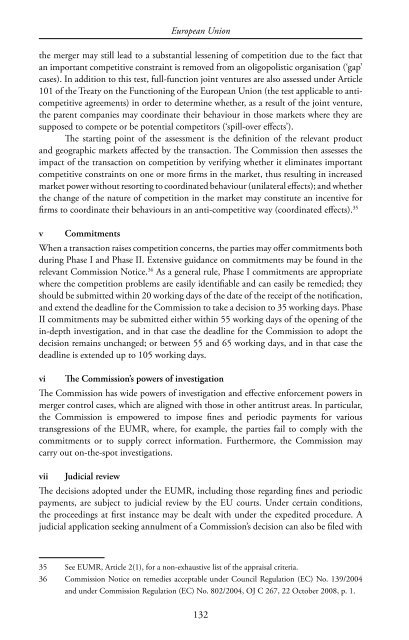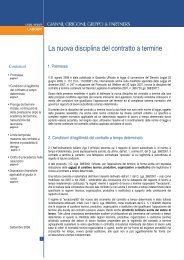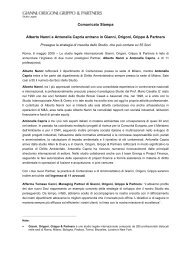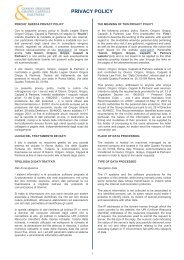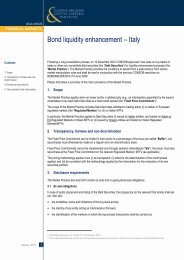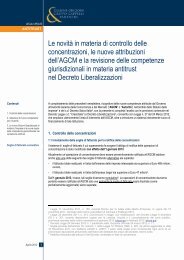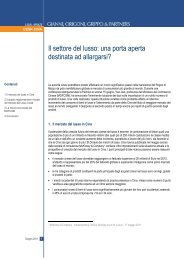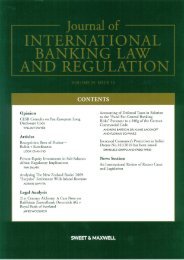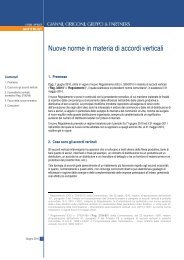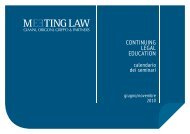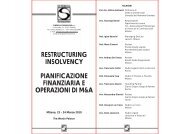The Merger Control Review - Gianni, Origoni, Grippo, Cappelli ...
The Merger Control Review - Gianni, Origoni, Grippo, Cappelli ...
The Merger Control Review - Gianni, Origoni, Grippo, Cappelli ...
You also want an ePaper? Increase the reach of your titles
YUMPU automatically turns print PDFs into web optimized ePapers that Google loves.
European Union<br />
the merger may still lead to a substantial lessening of competition due to the fact that<br />
an important competitive constraint is removed from an oligopolistic organisation (‘gap’<br />
cases). In addition to this test, full-function joint ventures are also assessed under Article<br />
101 of the Treaty on the Functioning of the European Union (the test applicable to anticompetitive<br />
agreements) in order to determine whether, as a result of the joint venture,<br />
the parent companies may coordinate their behaviour in those markets where they are<br />
supposed to compete or be potential competitors (‘spill-over effects’).<br />
<strong>The</strong> starting point of the assessment is the definition of the relevant product<br />
and geographic markets affected by the transaction. <strong>The</strong> Commission then assesses the<br />
impact of the transaction on competition by verifying whether it eliminates important<br />
competitive constraints on one or more firms in the market, thus resulting in increased<br />
market power without resorting to coordinated behaviour (unilateral effects); and whether<br />
the change of the nature of competition in the market may constitute an incentive for<br />
firms to coordinate their behaviours in an anti-competitive way (coordinated effects). 35<br />
v Commitments<br />
When a transaction raises competition concerns, the parties may offer commitments both<br />
during Phase I and Phase II. Extensive guidance on commitments may be found in the<br />
relevant Commission Notice. 36 As a general rule, Phase I commitments are appropriate<br />
where the competition problems are easily identifiable and can easily be remedied; they<br />
should be submitted within 20 working days of the date of the receipt of the notification,<br />
and extend the deadline for the Commission to take a decision to 35 working days. Phase<br />
II commitments may be submitted either within 55 working days of the opening of the<br />
in-depth investigation, and in that case the deadline for the Commission to adopt the<br />
decision remains unchanged; or between 55 and 65 working days, and in that case the<br />
deadline is extended up to 105 working days.<br />
vi <strong>The</strong> Commission’s powers of investigation<br />
<strong>The</strong> Commission has wide powers of investigation and effective enforcement powers in<br />
merger control cases, which are aligned with those in other antitrust areas. In particular,<br />
the Commission is empowered to impose fines and periodic payments for various<br />
transgressions of the EUMR, where, for example, the parties fail to comply with the<br />
commitments or to supply correct information. Furthermore, the Commission may<br />
carry out on-the-spot investigations.<br />
vii Judicial review<br />
<strong>The</strong> decisions adopted under the EUMR, including those regarding fines and periodic<br />
payments, are subject to judicial review by the EU courts. Under certain conditions,<br />
the proceedings at first instance may be dealt with under the expedited procedure. A<br />
judicial application seeking annulment of a Commission’s decision can also be filed with<br />
35 See EUMR, Article 2(1), for a non-exhaustive list of the appraisal criteria.<br />
36 Commission Notice on remedies acceptable under Council Regulation (EC) No. 139/2004<br />
and under Commission Regulation (EC) No. 802/2004, OJ C 267, 22 October 2008, p. 1.<br />
132


